
My Fight Against Hate Speech and Extremism Using Education, Photography, and Outreach
“IF NOT ME, THEN WHO?”
– 1st Lt. Travis Manion, United States Marine Corps.
I began teaching full-time as a lecturer in August of 2001 at IU South Bend. I soon became a senior lecturer and then chair of the department. In addition to teaching full-time, I completed a doctoral program through Texas Tech University. In 2013 I graduated with a PhD in Technical Communication and Rhetoric and then in August 2014 I accepted a tenure track assistant professor position at Longwood University in Farmville, Virginia. My research program was going to focus on visual and digital culture with an eye towards graphic narratives, the topic of my dissertation.
That would all change three years later.

In the summer of 2017, my cousin and his partner – fellow photographers living in Raleigh, North Carolina – invited me to go with them to photograph and document the Unite the Right protest in Charlottesville, Virginia in August. The alt-right was descending on the well-known college town for a second time to protest the removal of the Robert E. Lee statue from Emancipation Park. I had dabbled some in protest photography earlier in the year with the Science March on Washington DC, but this type of protest was different; it celebrated and lauded white supremacy all the while promoting hate speech. My cousin and his partner told me what to probably expect since they had more experience photographing hate groups than I did. With this in mind, my original goal was to make images of protest signs to use in my classes.
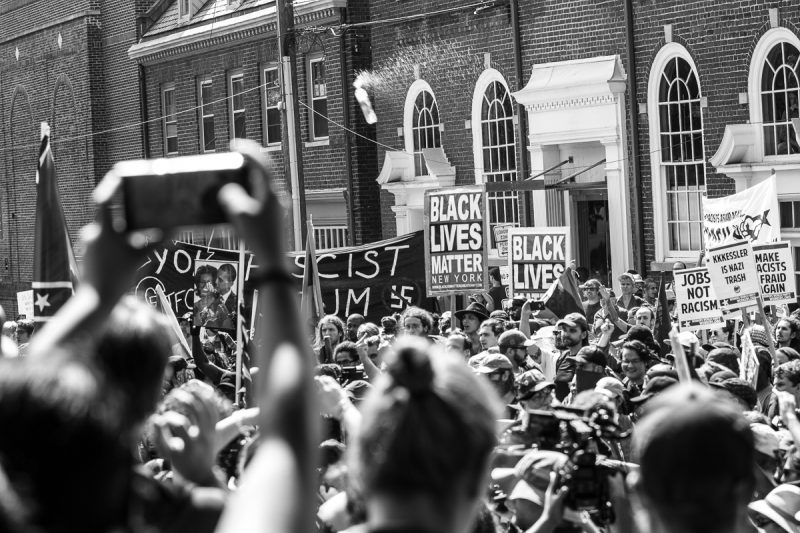
However, on that fateful weekend I saw hate firsthand. It was staring at me and there was nothing I could do about it. It was loud, physical, and constant. Alone, I realized my voice was not going to make a difference. In fact, it probably would have gotten me harmed in the moment, but I knew how to document events. I let my camera do the work I couldn’t, capturing an experience that I knew would change me and inevitably the landscape of how we looked at race, extremism, and hate across this country.
After that weekend I felt I needed to do something. If not me, then who? I quickly pivoted my research program from visual and digital culture to understanding and fighting the rhetoric of white supremacy and hate speech. Like a trained academic, I gathered books and started my research. To effect change, I needed to become knowledgeable about the opposition. Thus, the Beyond Hate project took root.
A VISION FOR BEYOND HATE
I consider myself a citizen-scholar: one that strives to make their work accessible for the general public and not just located in the annals of an academic journal open to a select audience. As the Center for Innovation in Teaching & Learning at the University of Illinois at Urbana-Champaign describes, “A Citizen Scholar adds social value to the world by participating in engaged scholarship that creates, applies, and disseminates knowledge to meet the needs of society.”
As a citizen-scholar, my goal with this project is to reach as wide an audience as I can to affect some modicum of change. To do this, I can’t just rely on traditional approaches that relegate information to niche audiences, like writing and publishing scholarly journal articles. Rather, I need to reach both scholars and the public equally in order to have maximum impact.
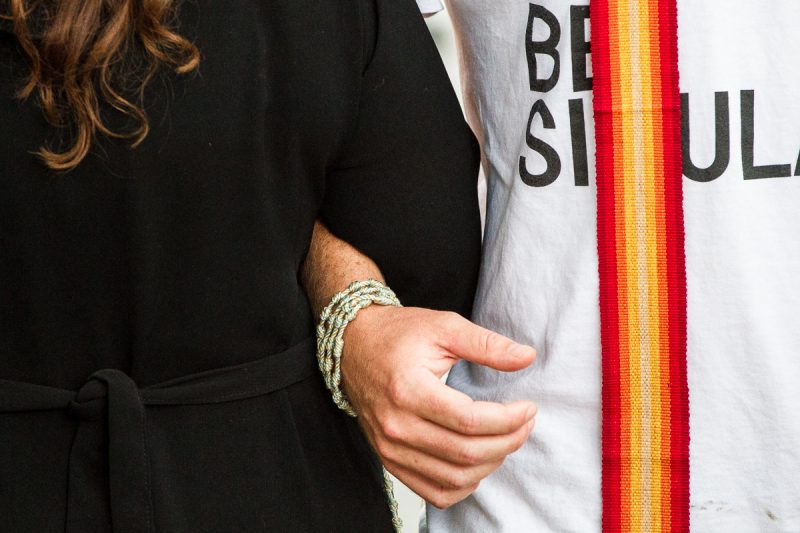
Beyond Hate is not just a repository for what I have already accomplished, but it also acts as a guide for future projects. It looks to the past and the present to understand how far we have come – both good and bad – and helps guide my work towards a future where we:
- Move beyond accepting hate as the status quo.
- Teach each other about the past, the present, and how we can impact the future.
- Act upon the rhetoric we encounter.
- Recognize the voices of marginalized groups and bring them to the forefront.
- Fight injustice using the tools at our disposal.
- Document what we see and use it as a vehicle for change.
- Protest with our voices.
- And finally, say “no more” to hate.
Beyond Hate is a rejection of hate and extremism and everything they stand for. But it is more than just standing up and saying, “no more.” We cannot move beyond hate unless we first confront it – and that is the scariest thought. Beyond Hate is a journey forward, not backwards. It recognizes the importance of the past in understanding the present to change our future; it is not complacency nor acceptance of what is. Rather, it is about making the most of our talents and harnessing them for productive change.
For me, Beyond Hate is a journey in fighting hate and extremist ideology using three tools I know best: photography, education, and outreach.
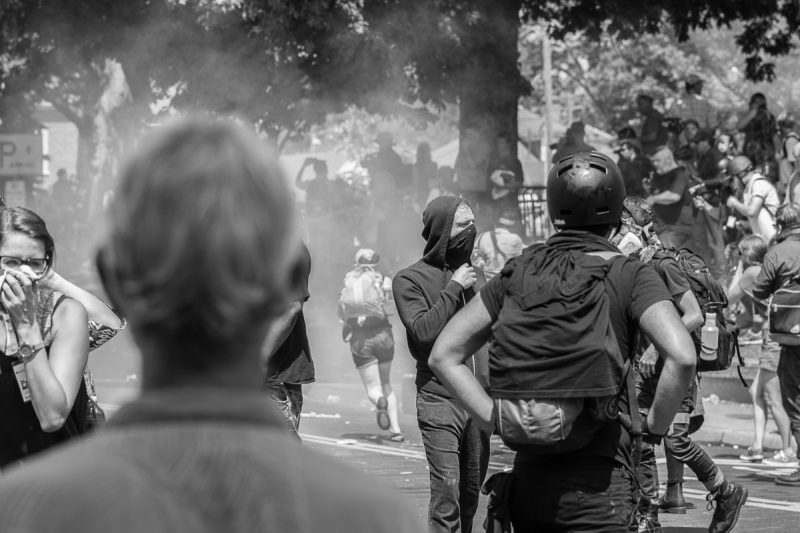
I. PHOTOGRAPHY
This project would not have come to fruition if not for the photographs themselves. All photographs are available in the Photodocumentary section on my website.
I am a photographer with almost three decades of experience capturing people, events, wildlife, architecture, and the everyday. I use this skill as both a creative and an educational outlet that augments my teaching. I went to Charlottesville in order to photograph protestors (white supremacists) and counter-protestors (anyone opposing the rally), thinking their signs and messaging would be useful in my courses. After seeing the vitriol and hate espoused in the Friday night torch rally on the University of Virginia campus, I felt a record of the weekend’s events would be even more important and impactful than just images of signs. What follows is a collection of exhibitions that told the story of what happened those fateful days in August of 2017.
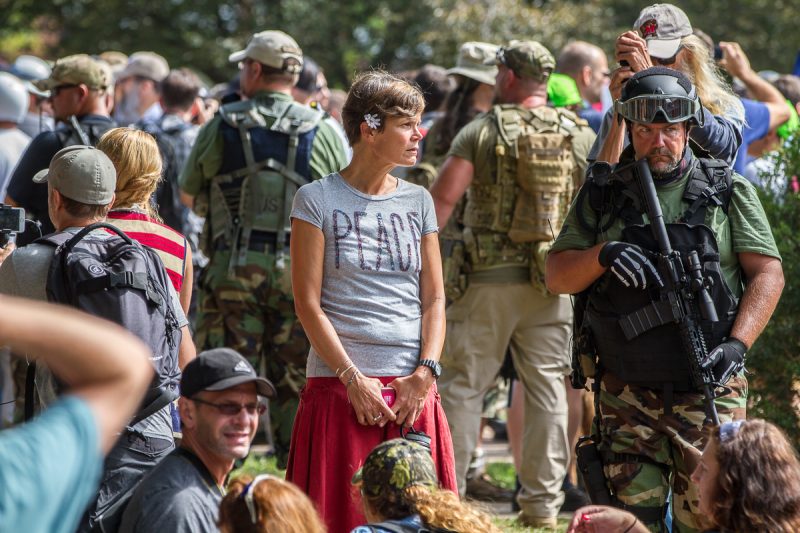
Unite the Right – 2017-2018
Images in this collection span events from 2017 through 2018 related to both Unite the Right and Unite the Right II.
- Friday, August 11, 2017 – The evening torch rally at the University of Virginia in Charlottesville, Virginia
- Saturday, August 12, 2017 – The Unite the Right rally at Emancipation Park in Charlottesville, Virginia
- Saturday, August 19, 2017 – Downtown Charlottesville, Virginia, one week after Unite the Right
- Sunday, August 12, 2018 – Unite the Right 2 rally and counter-protests at Lafayette Square in Washington DC
The University of Virginia Press contacted me about using several of my images in two books they published:
- Charlottesville 2017: The Legacy of Race and Inequality edited by Louis P. Nelson and Claudrena N. Harold. An image of the white supremacists surrounding the statue of Thomas Jefferson is used on the front cover of the book. Available at the UVA Press site.
- Summer of Hate: Charlottesville, USA by Hawes Spencer. Promotional materials include images I took from Saturday’s Unite the Right rally at Emancipation Park. Available at the UVA Press site.
BLM and the Death of George Floyd – Summer of 2020
After the death of George Floyd and the rise of the Black Lives Matter movement, I photographed several local events that documented my town’s peaceful protests as well as the graffiti and transformation of confederate statues on Monument Avenue in Richmond, Virginia.
- Peaceful Protest at the Prince Edward County Courthouse in Farmville, Virginia.
- March from the LOVE Sign to the Moton Museum in Farmville, Virginia.
- Graffiti on statues of Jefferson Davis, Robert E. Lee, and J.E.B. Stuart on Monument Avenue in Richmond, Virginia.
Photography Exhibitions
“There’s Just Us” – 2017-2019
I was invited to exhibit photographs from my collection at the Longwood Center for the Visual Arts from November 3, 2017 to February 18, 2018. Photos from the exhibition can be found on my website and the announcement of the exhibition can be found at the LCVA website. I was then invited to exhibit “There’s Just Us” at the Virginia Holocaust Museum in Richmond, Virginia. It ran from August 2, 2018 through October 28, 2018. Link to the exhibition.
This exhibition consisted of 10 of my images that told the events surrounding the August 11th and 12th white supremacist protests. In addition to these images, I compiled a DVD of the remaining images that accompanied the exhibit. My artist’s statement explained the exhibit and contextualized the images for viewers:
There’s Just Us
Alec R. Hosterman
It was early August in Charlottesville, VA. I was there to photograph the Unite the Right protests, first at the University of Virginia on Friday and then at Emancipation Park on Saturday. I saw the torches and watched the march. I read the signs and heard the vitriol. I witnessed the violence and heard about Heather Heyer. I didn’t know what to think.
At the end of that long and unforgettable Saturday, I attended the memorial for the victims of the tragic events that occurred when James Alex Fields Jr. smashed his car into a crowd of pedestrians on 4th Street, killing Heather and injuring dozens. Community members took turns speaking. During that time, I heard one person say, “There’s no justice; there’s just us.” I began to think about that statement and what it could mean.
There’s Just Us
August 11, 2017 • University of Virginia
I photographed the white supremacist evening tiki torch rally at the University of Virginia. I saw 300 white supremacists march from Nameless Field to the campus rotunda where a small band of 25 student counter-protesters surrounded the statue of Thomas Jefferson, arm-in-arm, representing diversity and inclusion. Those students could have said “there’s just us here tonight, so stay strong and be brave.”
August 12, 2017 • Emancipation Park
I photographed the alt-right’s Unite the Right rally. I watched as protestors had to walk through a row of religious leaders that were side-by-side and chanting “love has already won.” Those religious leaders could have said “there’s just us here today, so stay strong and remind them of love and compassion.”
I saw the protests turn violent; when smoke bombs, tear gas, pepper spray, paint balloons, urine balloons, and water bottles were thrown into crowds of counter-protestors. I saw bats being swung and aerosol cans being turned into flame throwers. I heard a gunshot. I saw brave souls countering the vile, obscenity-laced expletives with signs, flowers, and symbols of peace. Those counter-protestors could have said “there’s just us here today, so we’re going to combat hate with peace.”
There’s Just Us represents the struggle I saw when communities fight hate and bigotry; of the collective voices that were brave enough to stand up against all odds. It reminds us that we are never alone in the struggle for diversity and inclusion. Together, we can remember those voices who were silenced all too soon and make this world a better place to live.
There’s Just Us.
“There’s Just Us – 5th Year Anniversary” – 2022
To mark the 5th anniversary of Unite the Right’s impact on the Virginia community, the Virginia Holocaust Museum in Richmond, Virginia invited my photography exhibition back from August 1, 2022 to December 2022. Link to the exhibition notice. It includes an updated artist’s statement that reflects back on the past five years and the progress and obstacles encountered in that time.
Five years later, is the world a better place combatting white supremacy than it was in 2017? Has there been justice? Some would say no.
- In 2018, Robert Bowers killed 11 Jewish congregants at the Tree of Life synagogue in Pittsburgh, Pennsylvania.
- In 2019, Patrick Crusius killed 23 Latinos at a Walmart in El Paso, Texas.
- In 2019, Brenton Tarrant murdered 51 Muslims at two mosques in Christchurch, New Zealand.
- In 2022, Payton Gendron killed 10 African Americans in Buffalo, New York.
But some would say yes.
- According to the Southern Poverty Law Center, there were 954 established hate groups in 2017. By 2021, that number has dropped to 733.
- In 2021, the FBI thwarted an attempt by white nationalist group The Base to engage in violence at a pro-gun rights rally in Richmond, Virginia.
- In 2022, 31 members of Patriot Front were arrested on charges of conspiracy to riot before they could enter a pride event in Coeur d’Alene, Idaho.
- Now, more than ever, educational institutions, nonprofit organizations, government agencies, and individuals are working to help combat white supremacy on various fronts, through education, policy changes, writing books, and lawmaking.
Don’t let up. Combat white supremacy and racism.
Just us = Justice.
There’s Just Us.
II. EDUCATION
Teaching
By choice, I am a teacher. My academic training is in communication with an emphasis on rhetoric. For over 25 years I have been teaching courses that focus on how humans use different communication tactics to achieve their goals. My applied classes – like Public Relations Writing, Public Relations Campaigns, or Principles of Design Communication – are all about crafting a message and communicating with intent. My theory classes – like Deception and Lying, Digital and Social Media Technologies, or Visual Communication – are all about understanding how messages impact us and the way they function in different contexts. Regardless of the approach, rhetoric is at the heart of my teaching.
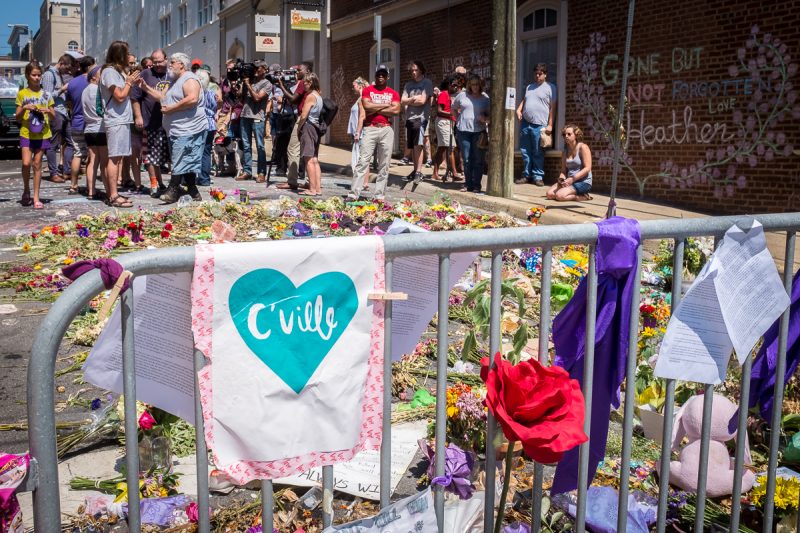
As part of Beyond Hate, I created a class titled Combating Hate Through Activism that is a combination history, application, and advocacy. The goals of the course are to:
- provide an historical review of the key events and figures in the American white supremacy movement
- explain how race, as a social construct, is used and shaped by those with power and privilege in order to justify discrimination
- identify and analyze the different communication tactics and symbols used by hate groups, persons, and events
- identify the different tactics used by hate groups when recruiting members
- design ways to confront and dismantle institutions of white supremacy, anti-Semitism, and/or hate speech
- become an advocate for those whose voice needs amplifying
The course is a blend of several disciplines – history, sociology, and communication – with special emphasis on the rhetorical threads that tie these disciplines together.
I first piloted a course in combatting extremism in the fall of 2020 using a freshman citizenship class called Inquiry into Citizenship; my theme was Confronting White Supremacy and Hate Speech. Two years later I refined the class and offered it as a special topics communication class called Fighting White Supremacy and Hate Speech. Using these two courses as the bedrock, I have developed a new course for my department: COMM 314 Combatting Hate Through Activism. Apart from being a departmental course offering, it will also serve in two other capacities:
- The Civitae curriculum (our general education program) as a Human Behavior and Social Institutions perspectives course. Students from across the university will be able to take it and have it count towards their Civitae credits.
- The Race and Ethnic Studies minor. The course will be one option for them to help complete their minor.
Public Presentations
Teaching is more than just conducting classes two or three times per week, lecturing, assigning work, and grading. Part of being a good teacher – and citizen-scholar – is disseminating what you know to others. Beyond Hate has given me the chance to take what I know out beyond the classroom and tell my story to others in a variety of venues. Presentations include:
- Private presentation to six diplomats from the Dutch Embassy taking part in Beyond the Beltway program in Washington D.C. They came to the Virginia Holocaust Museum in Richmond, Virginia for a tour of the facilities. I gave them a private presentation of my photography exhibit, There’s Just Us, on October 25, 2022.
- Keynote address to the Annual Meeting of the Virginia Holocaust Museum in Richmond, Virginia on September 19, 2022. The theme of my address was how the average person can fight anti-Semitism, white supremacy, and hate speech simply by using the tools they already have at their disposal.
- Artist’s Talk to the Virginia Holocaust Museum in Richmond, Virginia on August 2, 2017. I framed my talk around the ideas of perception and visual storytelling, two key elements in understanding the role of visual communication and culture. My goal was to provide an insider’s perspective on attending Unite the Right and how I went about photographing it, but to also show how images like mine become visual narratives, individually and taken together as a whole.
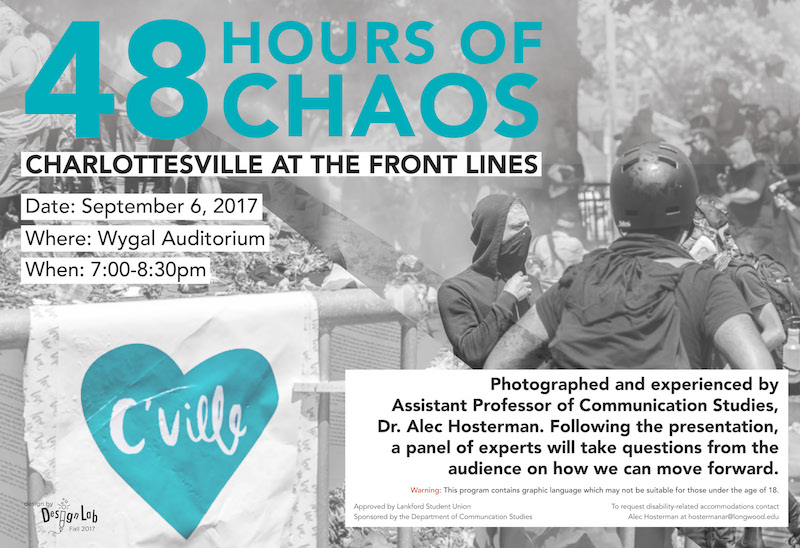
48 Hours of Chaos: Charlottesville at the Front Lines was a series of presentations I gave to organizations, academic classes, and the community. Interspersed with my photographs, I discussed the timeline of events, provide my experiences at the rally, and field questions from attendees.
- Academic conference presentation in November, 2019 at the 105th Annual National Communication Association Convention (Visual Communication division) held in Baltimore, Maryland.
- Public presentation on September 6, 2017 at Longwood University with a roundtable discussion afterwards. Dr. Naomi Johnson was moderator, Dr. Joan Neff provided opening remarks, and Dr. Pam Tracy moderated questions from the audience. The panel consisted of Dr. Jonathan Page, Dr. Dave Magill, Dr. Jennifer Glass, Dr. Virginia Beard, and myself. The presentation can be seen here.
- Private presentation to Dr. Heather Lettner-Rust’s ENG 400 class on August 27, 2017.
- Private presentation to the Longwood University Diversity Council on August 15, 2017.
Research and Grants
I am currently working on a book-length manuscript tentatively entitled Lessons Learned: The Impact of Unite the Right in the Fight Against White Supremacy. The book is a reflection on the impact of Unite the Right through the eyes of those who were there. Through interviews with activists, counter-protestors, clergy, business owners, politicians, journalists, and the like, I want to learn about that fateful weekend through their perspectives, see how far we have come since then, and what ordinary people can do to continue the fight against white supremacy and hate speech. The project is slated to begin in May of 2024 and continue through May of 2025.
III. OUTREACH
Tangentially, but no less important, is the outreach conducted because of my photography and public presentations. Interviews are an integral aspect to reaching a large audience for the projects in Beyond Hate. The following are interviews and promotions done for my photography exhibitions.
There’s Just Us – 5th Anniversary, 2022
- “A Riot Remembered” by Ale Egocheaga. Richmond Magazine. Link to the story.
- “There’s Just Us Exhibit Details 2017 Charlottesville Protests.” NBC 12 News. Link to the story.
- “Exhibit Reflects on 2017 Torch March and Rally.” CBS 19 News. Link to the story.
- “Hosterman’s Images Featured in Exhibit.” The Farmville Herald. Link to the story.
- “Photography Exhibit Marks 5th Anniversary of the Deadly Unite the Right Rally” by Crystal Graham. Augusta Free Press. Link to the story.
- “Art Notes for Aug. 11, 2022.” The Daily Progress. Link to the story.
There’s Just Us, 2017-2018
- “Exhibit Documents Charlottesville Protests, Aims to Inspire Action Against Hate.” WCVE 88.9 Richmond, Virginia NPR station.
- “Photographing the Charlottesville Protests with Alec Hosterman.” Valerie Jardin, host. Hit the Streets with Valerie Jardin: A Photography Podcast; Hit the Streets 50. Link to the podcast.
- “Charlottesville rally photos up at Virginia Holocaust Museum” by Jared Foretek. Washington Jewish Week. August 16, 2018. Link to the story.
- “Instagram Story.” WCVE 88.9 Richmond, VA NPR station. August 10, 2018. Link to the digital story.
- “Galleries Encourage Discussion” by Emily Hollingsworth. The Farmville Herald. November 7, 2017. Link to the story.